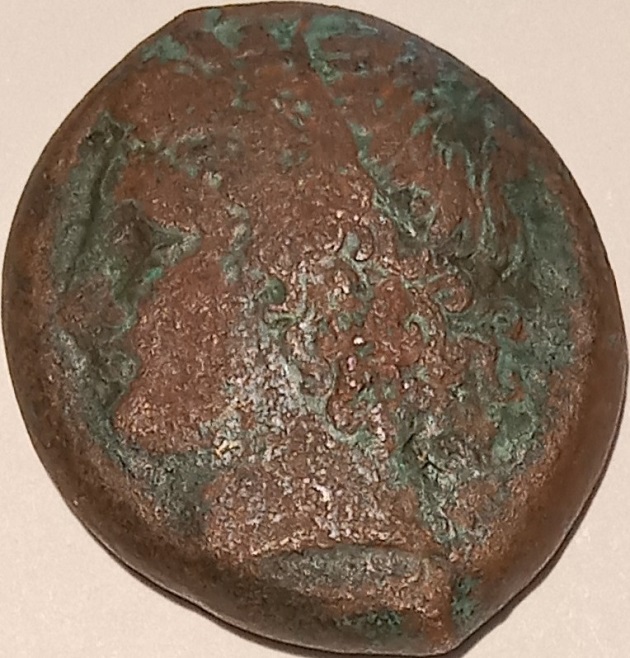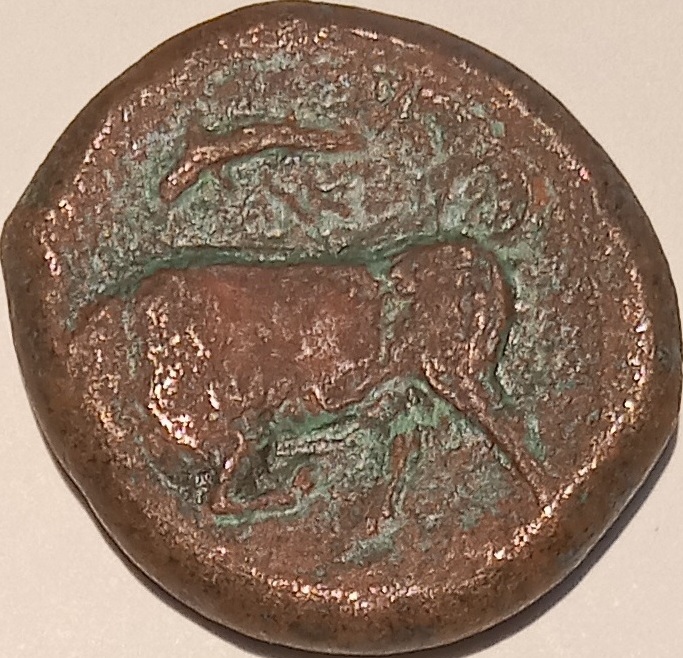|
Roma, 24.7.2023
Egregio
Lettore,
di seguito riporto gli elementi significativi
riguardanti la moneta di figura:
Æ
Emilitra1, zecca di
Siracusa, 317-289 a. C.2, SNG
Cop. Italy 2 Syracuse 758, BMC II
358 (pag.
194), https://www.magnagraecia.nl/coins/Area_IV_map/Syracusa_map/Syracusa2.html
Descrizione sommaria (sono indicate in rosso le
parti della leggenda usurate o comunque non più
leggibili):
D. Davanti ΣΥΡΑΚΟΣΙΩΝ3.
Al centro, Persefone, testa con serto di grano4 a
sinistra e collana. Bordo perlinato.
R. Toro cozzante5 a sinistra,
tra due delfini6
(uno solo visibile nella foto) a sinistra. Sopra il
toro, NK7.
Bordo liscio.
La ricerca nel web di monete della tipologia di
figura ha dato luogo ai seguenti risultati:
- vcoins
€299.12 Rates for: 07/21/23 Sicily, Syracuse. 317-289
(317-289 BC). Æ Hemilitron (23mm, 10.46g, 6h), c.
317-310. Head of Kore l., wearing wreath of grain
ears; shell behind. R/ Bull butting l.; dolphin
and NK above, dolphin below. CNS II, 96 DS 114;
SNG ANS 567-9 var. (obv. symbol); HGC 2, 1444.
Green patina, Good VF.
- https://auctions.bertolamifinearts.com/de/lot/62706/sicily-syracuse-agathokles-317-289-bc-/
LOS NR. 516 - E-LIVE AUCTION 77 Sicily, Syracuse.
Agathokles ... Ergebnis: 120,00 GBP Gebote: 3.
Sicily, Syracuse. Agathokles (317-289 BC). Æ
Hemilitron (22mm, 10.54g, 6h), c. 317-310. Head of
Kore l., wearing wreath of grain ears; shell
behind. R/ Bull butting l.; dolphin and NK above,
dolphin below. CNS II, 96 DS 114; SNG ANS 567-9
var. (obv. symbol); HGC 2, 1444. Green patina, VF.
- https://auctions.bertolamifinearts.com/it/lot/56182/sicily-syracuse-hemilitron-struck-under-/
LOTTO 174 - ASTA 67 Sicily, Syracuse, Hemilitron
... Aggiudicazione: 320,00 GBP Numero offerte: 4
Sicily, Syracuse, Hemilitron struck under
Agathokles, ca. 317-289 BC. AE (g10,38, mm23; h9)
ΣΥΡΑΚΟΣΙΩΝ, wreathed head of Kore l.; behind,
uncertain symbol, Rv. Bull butting l.; above, NK
and dolphin; below, dolphin. CNS 96; HGC 1444.
Dark patina and extremely fine.
- lot-art
LOT 413 Sicily, Syracuse, Hemilitron struck under
Agathokles, ca. 317-289 BC. AE (g10,71; mm22; h1).
ΣΥΡΑΚΟΣΙΩΝ, wreathed head of Kore l.; behind,
barley grain, Rv. Bull butting l.; above NK and
dolphin; below, dolphin. CNS 96; HGC 1444. Dark
green patina and good extremely fine. Start
price:£80
- vcoins
SICILY.SYRACUSE.Agathokles 317-289
BC.AE.Hemilitron.struck Circa 317-310 BC.Head of
Kore. Butting bull. Artistic dies, exceptional for
issue. €431.42 Rates for: 07/21/23 Pavlos S.
Pavlou, Numismatist Ancient Coins Greek Southern
Italy, Malta, North Africa and Spain. SICILY.
SYRACUSE.Agathokles 317-289
BC.AE.Hemilitron.struck Circa 317-310 BC.Head of
Kore. Butting bull. Artistic dies, exceptional for
issue. SICILY.SYRACUSE.Agathokles 317-289 BC.AE.
Hemilitron. struck Circa 317-310 BC.. (9.25g,
23.6mm, 9h) ΣΥP(AΚΟΣΙ)ΩΝ, head of Kore left, hair
bound with ribbon. Revers.Bull butting left, above
and below dolphin, above below dolphin monogram
NK. Ref:SNG ANS 567 var.(no symbol behind head).
Good very fine, legend weak. Above average
condition, struck from artistic dies.
- vcoins
SICILY, Syracuse. Agathokles. 317-219 BC. Æ
Hemilitron (22mm, 11g,). wreathed head of
Persephone left/ Bull butting left; above and
below, dolphin. €78.42 Rates for: 07/20/23 SICILY,
Syracuse. Agathokles. 317-219 BC. Æ Hemilitron
(22mm, 11g,). wreathed head of Persephone left/
Bull butting left; above and below, dolphin.
SICILY, Syracuse. Agathokles. 317-219 BC. Æ
Hemilitron (22mm, 11g,) wreathed head of
Persephone left / Bull butting left; above and
below, dolphin left; NK monogram above bull.
Holloway, "The Bronze Coinage of Agathokles,"
Essays Thompson, p. 87; Calciati II 96 Ds 114 R1
4; SNG ANS 567. VF,
- https://jetonscanada.com/en/product/syracuse-sicily-ae21-hemilitron-circa-317-to-310-persephone-bull-dolphin/
Syracuse Sicily AE21 Hemilitron Circa -317 to -310
Persephone Bull Dolphin. Sold "$80.00" on
"23-09-2021" Description Syracuse, Sicily, Time of
Agathokles, AE21, Hemilitron, Circa -317 to -310.
SNG ANS 561-3; HGC 2, 1444; CNS II, 96. Obv.: Head
of Persephone/Kore to left wearing wreath of grain
ears, ΣΥΡΑΚΟΣΙΩΝ before, barley grain behind.
Rev.: Bull butting to left; dolphin and [AI? (Or
NK, I can’t figure out which one and these two are
the most common] above, dolphin below. 10.44g
21.4mm.
- vcoins
€51.80 Quotazione: 07/21/23 Sicily, Syracuse.
Agathokles (317-289 BC). Sicily, Syracuse.
Agathokles (317-289 BC). Æ Hemilitron (23mm,
10,1g,), c. 317-310. Head of Kore l., wearing
wreath of grain ears; shell behind. R/ Bull
butting l.; dolphin and NK above, dolphin below.
CNS II, 96 DS 114; HGC 2, 1444. Green patina, VF.
- cngcoins
Electronic Auction 538 Lot nuber 32 SICILY,
Syracuse. Agathokles. 317-289 BC. Æ Hemilitron
(21.5mm, 9.50g, 2h). Struck circa 317-310 BC. VF.
Electronic Auction 538 Lot: 32. Estimated: $150.
Greek, Bronze. Sold For $ 140. SICILY, Syracuse.
Agathokles. 317-289 BC. Æ Hemilitron (21.5mm, 9.50
g, 2h). Struck circa 317-310 BC. Wreathed head of
Kore left; barley grain behind neck / Bull butting
left; above, dolphin left above NK monogram;
below, dolphin left. CNS 96 Ds30 R13; BAR Issue 8;
HGC 2, 1444. Dark green patina, some roughness.
VF. Ex Pegasi Numismatics inventory 10052442 (ND).
Closing Date and Time: 10 May 2023 at 10:10:20 ET.
- https://auctions.bertolamifinearts.com/it/lot/62704/sicily-syracuse-agathokles-317-289-bc-/
LOTTO 514 - E-LIVE AUCTION 77 Aggiudicazione:
60,00 GBP Numero offerte: 1 Sicily, Syracuse.
Agathokles (317-289 BC). Æ Hemilitron (22mm,
7.05g, 11h), c. 317-310. Head of Kore l., wearing
wreath of grain ears; poppy(?) to r. R/ Bull
butting l.; dolphin above. CNS II, 96; SNG ANS
570-1; HGC 2, 1444. Green patina, near VF.
- https://www.forumancientcoins.com/catalog/roman-and-greek-coins.asp?zpg=81486
In 311 B.C., Agathocles, the tyrant of Syracuse,
invaded the Carthaginian holdings on Sicily and
laid siege to Akragas. Hamilcar led the
Carthaginian response, and by 310 controlled
almost all of Sicily and laid siege to Syracuse
itself. In desperation, Agathocles secretly led an
expedition of 14,000 men to Africa, hoping to save
his rule by leading a counterstrike against
Carthage itself. Carthage was forced to recall
Hamilcar and most of his army from Sicily.
Agathocles was eventually defeated in 307 B.C.,
but he escaped back to Sicily and negotiated a
peace which maintained Syracuse as a stronghold of
Greek power in Sicily. GB90149. Bronze AE 24, cf.
Calciati II p. 218, 96 DS 114 R1 4 (amphora); BMC
Sicily p. 194, 358 (barley kernel); SNG Cop 757
(same); SNG ANS 567 (trophy); SNG Munchen -, aVF,
superb classical style, old light scratches,
Syracuse mint, weight 10.039g, maximum diameter
22.8mm, die axis 90o, 317 - 289 B.C.; obverse
ΣYPAKOΣIΩN, head of Kore left, wreathed with
grain, amphora(?) behind; reverse bull butting
left, dolphin over NK monogram above, dolphin
below; ex Ancient Imports (Marc Breitsprecher); ex
Coin Galleries mail bid, 14 Nov 1984, part of lot
327; SOLD.
Concludo osservando che le caratteristiche fisiche,
generali e di stile della moneta non si discostano
da quelle delle monete autentiche di pari tipologia
reperite nel web. Nel presente stato di
conservazione la moneta, se autentica, vale a mio
avviso, una trentina di euro.
Un saluto cordiale.
Giulio De Florio
-------------------------------
Note:
L'Æ Emilitra
(Hemilitron) aveva un peso variabile, a seconda
del tempo e del luogo. Quella di Siracusa del
periodo di Agatocle aveva un peso di 8.35÷11.90g
(v.
link). Raccolgo in tabella le
caratteristiche fisiche delle emilitre della
tipologia di figura presenti nei
link sopra indicati:
| Link |
Peso(g) |
Asse di conio (ore-h) |
Diametro(mm) |
| 1 |
10,46 |
6 |
23 |
| 2 |
10,54 |
6 |
22
|
| 3 |
10,38 |
9 |
23 |
| 4 |
10,71 |
1 |
22 |
| 5 |
9,25 |
9 |
23,6 |
| 6 |
11 |
- |
22 |
| 7 |
10,44 |
8 |
21,4 |
| 8 |
10,1 |
- |
23 |
| 9 |
9,50 |
2 |
21,5 |
| 10 |
7,05 |
11 |
22 |
Dalla tabella si evince che le caratteristiche
fisiche della moneta di figura (8,7g, 22mm, 9h)
rientrano nei margini di variabilità delle monete
d'epoca dello stesso tipo.
(2) 317-2896 a. C. (il tempo di
Agatocle). Agatocle
(in greco antico: Ἀγαθοκλῆς) è stato tiranno di
Siracusa dal 317/316 a.C. e basileus di Sicilia dal
307 a.C. o dal 304 a.C. fino alla morte. Nacque da
una famiglia di umili origini e, grazie alla
prestanza fisica e abilità militare, riuscì ben
presto a scalare le vette del potere della Pentapoli
di Siracusa. Nel contesto della guerra civile di
Siracusa, divenne prima capo fazione dei democratici
e in seguito venne nominato «stratega e custode
della pace». Alla fine della guerra prese, con un
atto di forza, il titolo di stratēgòs autokràtōr
(στρατηγὸς αὐτοκράτωρ) e instaurò a Siracusa una
nuova tirannide. Il suo governo fu in linea con
quelli sorti in epoca ellenistica, segnata da
numerosi conflitti bellici e nuove scoperte
territoriali. Durante la riaccesa ostilità tra
Cartagine e i Sicelioti, Agatocle affrontò per la
prima volta i Cartaginesi su suolo africano durante
la spedizione siracusana in Africa, andando a minare
le certezze dell'inviolato impero dei Punici.
(3) ΣΥΡΑΚΟΣΙΩΝ,
scritta illeggibile sul dritto della moneta,
costituisce l'etnico (moneta dei Siracusani).
(4) Persefone, riconoscibile dal
serto di spighe sulla testa, era considerata, come
la madre Demetra, dea delle messi. Molto noto è il
mito di Persefone: generata dall'unione di Demetra
con Zeus, fu un giorno rapita. Demetra corse nove
giorni disperata, per terra e per mare, alla sua
ricerca prima di apprendere che, a rapirla, era
stato Ade, re degli Inferi, con il consenso di Zeus.
Demetra si chiuse allora nel suo dolore e la terra
divenne sterile, sino a che Zeus non concesse a
Persefone di poter far ritorno ogni anno sulla terra
per sei mesi, tra la primavera e l'autunno. Demetra,
placata, riprese il suo posto nell'Olimpo, da dove
fu di nuovo dispensiera di fecondità e fertilità per
la terra. Agatocle, alla fine del IV secolo (v.
link), utilizzò Persefone come tipo monetale,
per manifestare un potere politico che intendeva
estendere a tutto il paese. L'impresa africana di
Agatocle è ricca di dettagli che mostrano il suo
coinvolgimento con Demetra.
(5) L’icona del cosiddetto “toro
cozzante” evoca un impeto travolgente, rivelando
l’intento della comunità emittente di comunicare
vitale energia.
(6) La presenza dei delfini nel
rovescio allude forse alla potenza marittima
(7) NK, di incerta
interpretazione, forse il nome del magistrato
monetale. |

